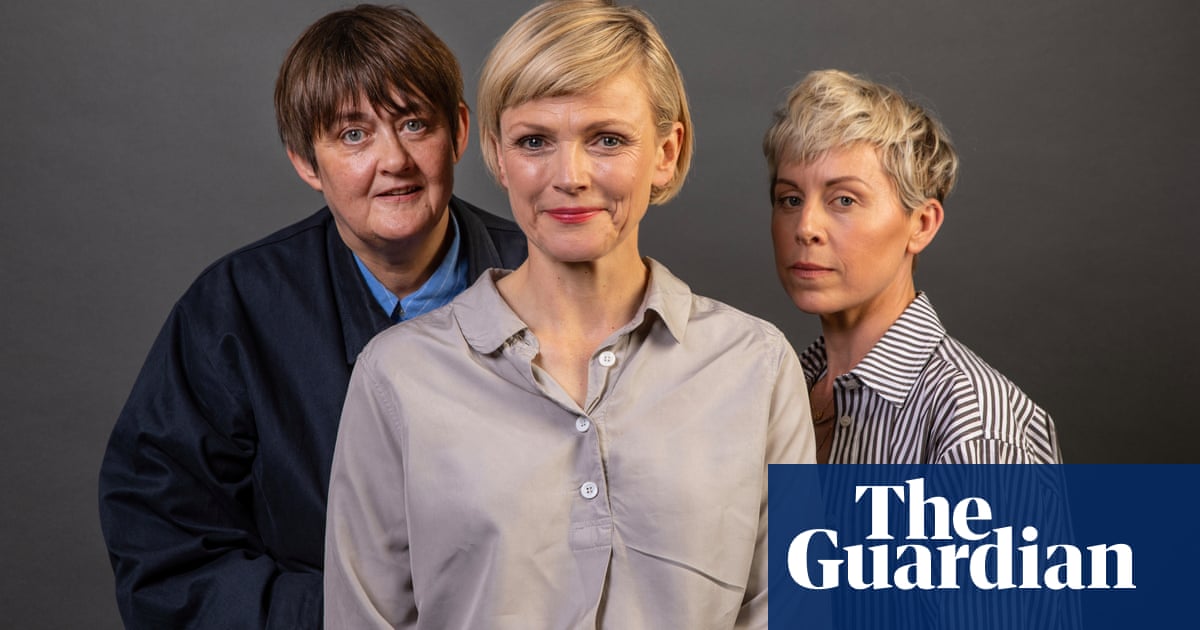
Spencer, the new film about Princess Diana, is very definitely not The Crown. Not for director Pablo Larraín the comforting grandeur of Peter Morgan’s Netflix series, whose tapestried locations are the scene of inner turmoil as private desires hit the buffers of public duty. Spencer, the imagined story of which takes place over three ghastly days at Sandringham in 1991, veers far more gothic. The Norfolk stately home becomes a kind of Overlook Hotel from Stanley Kubrick’s horror classic The Shining, through whose endless, confusing corridors the camera harries and chivvies Kristen Stewart’s Diana as her psyche crumbles.
Stewart and Larraín are with me in a Zoom room: the director has his camera off, a mere black square and a courteous Chilean voice; Stewart, a relaxed, enthusiastic presence in a depersonalised domestic space, wearing a baggy red top, her hair loose and blond.
Larraín loves the Kubrick comparison, originally made in the Guardian’s review from the Venice film festival, where the movie premiered. “He was so excited when he read that,” says Stewart.
For the character of Diana, however, the “tentpole reference”, Stewart says, was that unforgettable portrait of a mind cornered into insanity, Gena Rowlands in John Cassavetes’s 1974 film A Woman Under the Influence – “not maybe in the detail of the character,” says Larraín, “but in the sensibility”. In Spencer, which is set over the royal family’s three-day Christmas get-together, we see the princess desperately wielding wire-cutters in a ballgown; breaking into her crumbling childhood home; and, weirdly, clutching so ferociously at her string of pearls during a terrible Christmas Eve dinner that the beads clatter into her bowl, which she then spoons up with her soup and has a good chew on. The film, in case it isn’t already clear, leaves the borders of realism far, far behind. I am not sure it is recommended viewing for the real Diana’s sons; although, as with A Woman Under the Influence, the one place of stability for the protagonist is her tender relationship with her children.
Stewart spent some months perfecting her Diana, she says, coming up with an evocation of the princess’s whispery, rushed diction and wry little laugh that was pitch-perfect enough to allow her to feel a sense of freedom in the role. Her dialect coach was William Conacher, who turns out to be all the Dianas’ coaches: Emma Corrin (The Crown) and Naomi Watts (Diana) also worked with him. The accent, she says, was important, but more so, the whole manner: “She had such a particular way of talking, and she makes me feel something so specific to her,” she says. “It was like a full-body exercise – the most muscular, unintuitive, yet extremely instinctive thing. It was weird: I needed to master it in order to kind of mess it up.”
She continues: “I don’t know if I believe in anything. I don’t believe in ghosts, but I don’t not believe in ghosts. I believe in a lingering energy. I took her in, whether or not it was my idea of her or there was some actual literal remnant of her.”
Perhaps I look a little alarmed, because she adds: “I guess it sounds kooky to start talking about stuff like this. But there wasn’t a day that went by that I wasn’t like: ‘What does she think about this? I wonder if she can see me?’”
It does indeed sound kooky. There again, I say, it must have been strange to immerse oneself in the world of this most famous, loved and vulnerable of women. “I guess the difference between playing somebody who existed in real life versus in someone’s imagination exclusively, is talking about it afterwards and wondering how people are going to receive it,” she says. “Because when you are creating a character from scratch you still create a mythology, a list of facts that are true to the person you construct so that that person feels whole to you.
“I’m not actually Princess Diana, I can’t know everything about her. She’s in our movie. She is a character: she exists in this story as something that I feel to be whole,” she adds. Having Larraín talk about A Woman Under the Influence, telling her, “I think we go that far, I think we go that hard” was, she says, exhilarating and terrifying, like the feeling “right before you ride your bike fast down a hill, and you’re like: ‘Oh, fuck!’”
In Spencer, the viewer is edged into seeing events from Diana’s off-kilter perspective, just as in Larraín’s Jackie (2016), where the days following the assassination of John F Kennedy were seen through the grief of his widow, played by Natalie Portman. (“I don’t think I would have made Spencer without Jackie,” Larraín says. “One thing led to another. Both women that had to deal with the press and media in different ways, both women that were linked to very powerful families married to powerful men, and they were both women that find the way to create their own story and find their identity. But if Jackie’s a movie about grief and memory and legacy, I think Spencer is about identity and motherhood.”)
At the start of Spencer, Diana is driving down to Sandringham alone in her open-topped Porsche – a rebellious move in itself, since she is without security or minders. “Where the fuck am I?” she asks, out loud. She is completely lost, physically and spiritually, and gets more so as soon as she enters the gloomy portals of Sandringham.
The fact that the “Sandringham” exteriors were in fact filmed at a vast German schloss, its facades as blank and regular as a prison, rather than anything resembling the chaotic 1880s architectural bodge that the Norfolk house really is, adds to the sense of Diana entering, in Larraín’s words, “a labyrinth that is endless” – a place that is, in some chilling way, “an extension of her own psychology”. Later, I wonder whether the screenwriter Steven Knight (who wrote Dirty Pretty Things and was one of the creators of Who Wants to Be a Millionaire?) imbibed the remarkable private notes James Pope-Hennessy made about Sandringham in the 1950s, collated by Hugo Vickers in the recent book The Quest for Queen Mary. For Pope-Hennessy – the official biographer of Queen Mary, the Queen’s grandmother – Sandringham was “emphatically, almost defiantly hideous and gloomy … a hideous house with a horrible atmosphere in parts, and in others no atmosphere at all. It was like a visit to a morgue …”
Diana is trapped there as surely as Wendy Torrance is trapped in The Shining. “It’s a cold space of repression,” says Larraín, “a space that represents oppression and fear next to, and in crisis with, a character that is as fragile and warm as Diana.” Not that Diana is wholly sympathetic. Stewart describes her character’s contradictory interior life as “this bingeing, purging, self-hating, arrogance and entitlement”. A shot of darkness can be no real surprise from the director of the bleakly funny Tony Manero (2008), Larraín’s early, Spanish-language film set during the Pinochet dictatorship, about a man who will commit murder in pursuit of his obsession with John Travolta in Saturday Night Fever.
Labyrinths generally contain monsters. Spencer stops just short of suggesting that the real minotaur at the heart of the maze is the royal family. The Queen et al are rendered as mere suggestions, vague spectral presences, with the exception, perhaps, of Prince Charles, who is not so much diabolical as just terribly chilly. It’s Timothy Spall’s appallingly sinister equerry, his face like a tombstone, who really scares the bejaysus out of Diana (and the viewer). In one memorable scene, he apparates into the walk-in refrigerator, to which, in the small hours, the princess, in the grip of an eating disorder, has ventured to contemplate tottering towers of cakes, pastries and petits fours.
It is scenes such as these that send out early alerts not to mistake Spencer for anything like realism. (The film did, in fact, employ two advisers on royal matters, one of whom dishes out protocol wisdom on The Crown, the courtier-ish David Rankin-Hunt, who worked in the royal household for 33 years.) The film is inviting us to see the food here not as an accurate rendering of Christmas dining at Sandringham (which I imagine is a good deal plainer than what we see), but, as something that, viewed through the lens of Diana’s eating disorder, becomes tempting, threatening and overwhelming. This all plays out particularly twistedly during that Christmas Eve dinner scene, extravagantly candlelit à la Barry Lyndon – a film that, Larraín says, was a more conscious Kubrick reference point than The Shining.
A string quartet plays for the assembled family, but as the scene develops, gradually the music deliquesces from a stately Handel-esque dance into jazz. Jonny Greenwood of Radiohead wrote the score. “The original idea I talked Pablo into,” he tells me by email, “was to hire a full baroque orchestra, write some Handel-inspired pieces, and while they were playing, substitute the players one at a time with free jazz musicians – so, a jazz trumpeter for the natural trumpet player, jazz organist taking over from the church organist, and so on. And have these transitions happening at various speeds.” That is more or less what happened, although due to Covid restrictions, they could use only eight players in a room at a time. “It mostly worked, bar one disastrous cue which sounded like the Antiques Roadshow theme played by drunkards,” he adds. “Gothic horror was certainly the aim. I mean, here’s the innocent girl lured to the gigantic, cold castle, with servants appearing from nowhere, and impossibly perfect mountains of food. I think those are all tropes which were interesting to focus on. And just play with the colourful contrast between the baroque and jazz stuff; Diana was pretty wild and colourful in that setting.” Larraín cut the scene to the score. For him, the jazz motifs represent how the movie adjusts its perspective from one of royal calm and formality to “inside Diana’s psychological crisis”. The jazz signals Diana’s internal chaos, but also, ultimately, her way out of the nightmare.
Because Diana does have allies in the film, one of them a dresser, Maggie, played by Sally Hawkins, who at one point (spoiler alert) avows her love – her real, in-love love – for the princess. It is a somewhat jolting moment. Was there any basis for it in reality, as far as Larraín knows? “It’s probably a question for Steve,” says Larráin, “but I think probably it was complete invention.”
Stewart chips in. “Diana was a frustrating person, a divisive person, but there were a lot of people that were truly just taken, and in love with her, unbeknown to her; and ironically, she was also somebody who was deeply rejected … what I really loved about [that scene] was watching someone naively, out of this deep dark hole of isolation, be presented with stark, honest love and care.”
Diana is given, then, a temporary reprieve. Lightness infuses the dark. Nonetheless, it seems that the film – via all sorts of hints, not least some perhaps heavy-handed imagery to do with a dead pheasant – invites viewers to form the conclusion that the royal family were directly or indirectly responsible for Diana’s death, six years after the events depicted. Is that what Larraín thinks? “It’s not that I want to avoid the question, but I don’t want to be the one who is telling the audience what to see and what to feel,” he says. “My job is to put those things on screen so everyone can have their own conclusion.” Take from that what you will.












